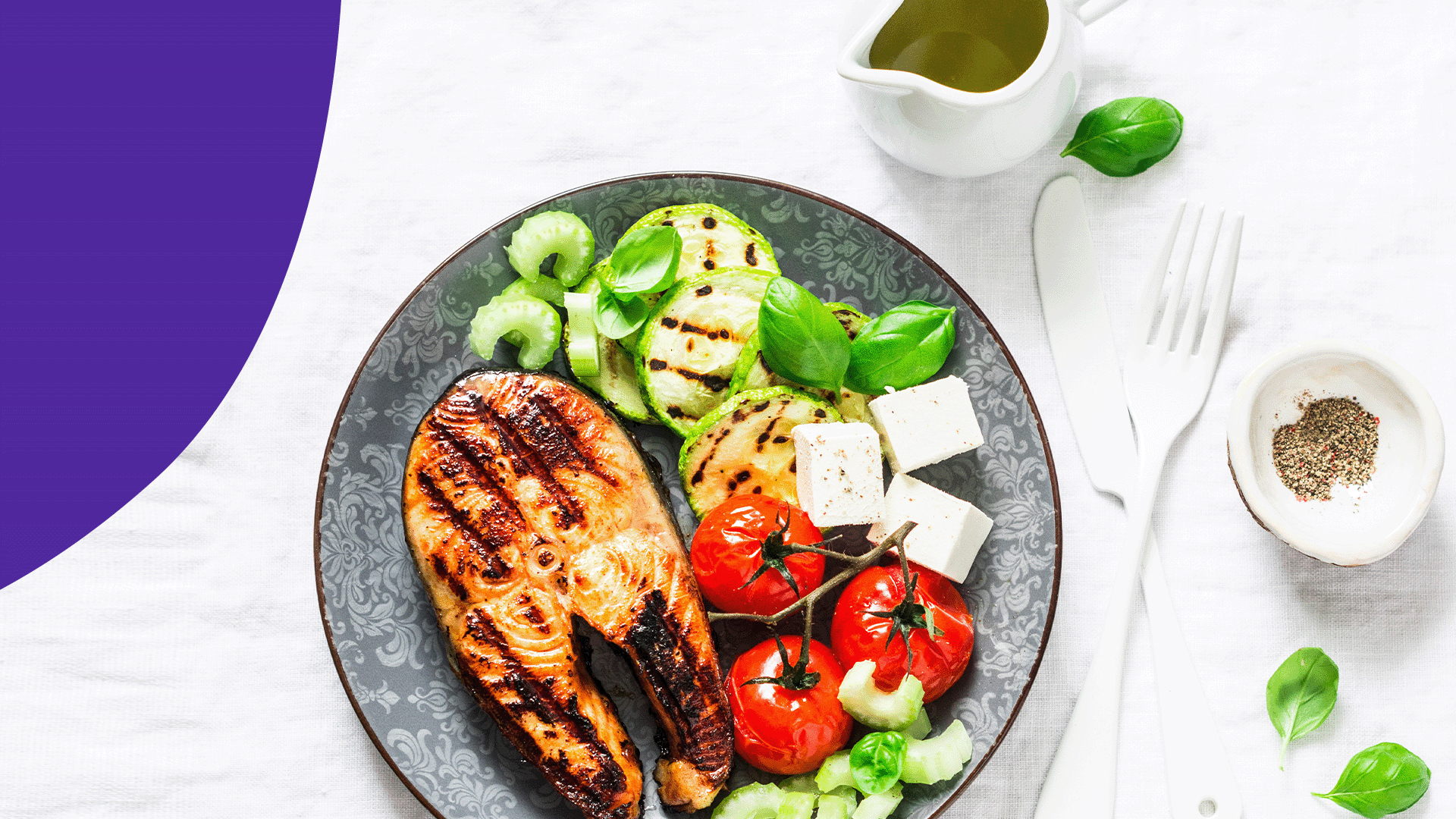
A high-fiber diet with three to five portions of whole grains per meal can help prevent diabetes. Karen Ansel, a Syosset-based registered dietitian nutritionist, said that people who drink coffee daily are 54% less likely to develop type-2 diabetes than those who don't. This condition can also be prevented by eating high-quality fiber, vitamin C, and lutein.
Cruciferous vegetables are high-in antioxidants, which may prevent diabetes. Sulforaphane in spinach is thought to reduce the risk of both heart disease (and inflammation). Omega-3 fats are abundant in salmon, but other fish rich in this nutrient can be eaten. You might also like trout, albacore tuna and herring. To cut down on calories, you can bake fish instead of baking it. According to the American Diabetes Association, fish should be eaten at least twice per week.

Your health is better if you eat a lot of fruits and vegetables. High intake of vegetables and fruits is good for your overall health. You should eat a wide variety of fruits, vegetables, and especially citrus fruits. Red meat and dairy products should be limited if you have diabetes. Your best option is to eat more fruits, vegetables and dairy products. Although this may be more difficult in the beginning, it will help to reduce the risk of developing type 2 diabetes over time.
Yogurt has many benefits for people with diabetes. High-quality protein and calcium are found in yogurt. Plus, yogurt contains no sugar. Probiotics help balance the bacteria in your digestive tract. People with lactose intolerance may still eat yogurt as long as they choose Greek varieties. This yogurt has less lactose content than its regular counterpart. But, people with lactose intolerance can still eat it.
Another type of food that prevents diabetes is legumes. These high-fiber and protein foods can help stabilize your blood sugar. These foods can also lower your chances of developing type 2 diabetes. They are also high in protein so you don't need snacks. In addition to being rich in antioxidants, legumes can help fight inflammation. This is one of the main causes of type II diabetes.

Oatmeal is rich in fiber and can reduce your appetite before lunch. A study found that people who consume 4 to 5 servings of oatmeal each day have a lower likelihood of developing type II diabetes than those who consume less fiber. Fiber also helps regulate blood sugar levels which can help lower the risk of developing diabetes. If you have a history of diabetes, be sure to eat plenty of these foods to prevent this disease.
FAQ
What are 10 healthy lifestyle habits?
-
Get breakfast every morning.
-
Don't skip meals.
-
Maintain a balanced diet.
-
Get plenty of water.
-
Take care of yourself.
-
Get enough sleep.
-
Avoid junk foods.
-
Do some exercise every day.
-
Have fun!
-
Find new friends
How to measure your body fat
A Body Fat Analyzer will give you the most accurate measurement of body fat. These devices are used to measure body fat for people who want weight loss.
What is the best way to live a healthy lifestyle?
Healthy lifestyles include eating healthy food, regular exercise, good sleep, and avoiding stress. These guidelines will help you live a long, healthy life.
Start small by changing your diet and exercising routine. If you're looking to lose weight, walk for 30 minutes each morning. If you're looking for a way to increase your activity, consider taking up swimming or dancing. You could also sign up to an online fitness platform like Strava, which tracks your activity.
Exercise: Good or bad for immunity?
Exercise is good for your immune system. Exercise increases white blood cell production, which helps fight off infection. You also get rid of toxins from your body. Exercise can prevent diseases such as cancer and heart disease. It can also lower stress levels.
However, overtraining can damage your immune system. You can cause muscle soreness by working out too hard. This can cause inflammation as well as swelling. Your body will then produce more antibodies in order to fight infections. The problem is that these extra antibodies can cause allergies and autoimmune disorders.
So, don't overdo it!
Why does our weight change with age
How can you tell if your bodyweight has changed?
A person who has less body fat than their muscle mass will experience weight loss. This means that you must consume more calories than you use daily. The most common cause of weight loss is decreased activity levels. Other factors include stress, illness and pregnancy. Weight gain occurs when there is more fat than muscle mass. It occurs when people eat more calories than what they use in a given day. Overeating, increased physical activity and hormonal changes are all common reasons.
The primary reason we lose weight is that we consume less calories than what we burn. Exercise regularly increases your metabolism rate, which allows you to burn more calories every day. But, this does not mean that we will be thinner. It is important to know if we are losing weight or gaining muscle. We will lose weight if we burn more calories than we consume. But, if we consume far more calories than what we burn, then we actually store them as fat.
As we grow older, we tend to become slower at moving around and therefore we don't move as much. We also tend have less food to eat than when our children were young. Also, we are more likely to gain weight. On the flip side, we tend to have more muscle mass so we look bigger than we really are.
There's no way to tell how much weight you've lost unless you weigh yourself every week. There are many ways to determine your weight. You can measure your waist, hips and thighs as well as your arms. Some people prefer to use bathroom scales while others like to use tape measures.
If you want to track your progress, you should try weighing yourself once a week and measuring your waistline once a month. You can also take photographs of yourself every few years to track how far your progress has been.
You can also check your height online to find out how many pounds you have. For example, if you're 5'10" tall and weigh 180 pounds, you'd probably weigh 180 pounds.
What is the working principle of an antibiotic?
Antibiotics are drugs that destroy harmful bacteria. The treatment of bacterial infections is done with antibiotics. There are many different types of antibiotics. Some are taken orally, some are injected, and others are applied topically.
People who have been infected with certain germs may need antibiotics. An oral antibiotic might be prescribed to someone who has been exposed to chicken pox. This will prevent the spread of shingles. A penicillin injection might be given to prevent pneumonia in someone who has had strep.
When antibiotics are given to children, they should be given by a doctor. Children are at greater risk than adults for developing serious side effects from taking antibiotics.
Diarrhea is the most common side effect from antibiotics. Other side effects that could occur include nausea, vomiting and dizziness. Most of these symptoms disappear after the treatment is completed.
Statistics
- WHO recommends consuming less than 5% of total energy intake for additional health benefits. (who.int)
- Extra virgin olive oil may benefit heart health, as people who consume it have a lower risk for dying from heart attacks and strokes according to some evidence (57Trusted Source (healthline.com)
- According to the 2020 Dietary Guidelines for Americans, a balanced diet high in fruits and vegetables, lean protein, low-fat dairy and whole grains is needed for optimal energy. (mayoclinichealthsystem.org)
- WHO recommends reducing saturated fats to less than 10% of total energy intake; reducing trans-fats to less than 1% of total energy intake; and replacing both saturated fats and trans-fats to unsaturated fats. (who.int)
External Links
How To
How to keep yourself motivated to exercise and eat well
Healthy living: Motivational tips
Motivational Tips For Staying Healthy
-
List your goals
-
Realistic goals
-
Be consistent
-
When you reach your goal, reward yourself
-
If you fail the first time, don't lose heart
-
Have fun